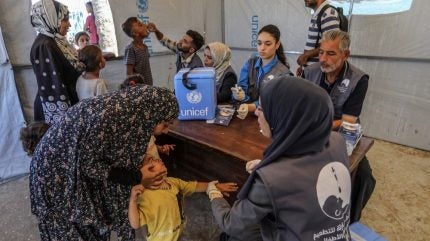
The Global Polio Eradication Initiative (GPEI) has delayed its target to eradicate the disease, pushing it back from 2026 to 2027 for wild poliovirus (WPV), and 2029 for the type 2 variant poliovirus.
The delay comes alongside calls for further financial backing, as efforts to eradicate polio encounter challenges in conflict-affected areas, including in Gaza, Sudan, and Yemen.
The strategy was initially projected to cost $4.8bn for the 2022–2026 strategic period, but updated estimates predict that, with the period extending to 2029, the cost will increase to $6.9bn. A total of $4.5bn has been committed by donors so far, leaving a $2.4bn shortfall.
The lack of health infrastructure in areas of conflict is both a key reason behind the spread of polio and an obstacle to vaccine rollout.
This is the case in Gaza, where polio had been eradicated for 25 years, until circulating variant poliovirus type 2 (cVDPV2) was detected in six environmental samples – or wastewater – collected from central Gaza in June 2024.
WHO reported last month that only 17 of 36 hospitals remained partially operational in Gaza, and warned that primary healthcare and community-level services are frequently suspended due to evacuation orders and Israeli attacks.
UN-backed agencies launched a two-phase vaccination campaign in response to the positive samples. The first phase commenced on 1 September, and was conducted over 12 days by 513 teams, consisting of over 2,180 health and community outreach workers. It saw 181,429 children aged under ten years vaccinated with the novel oral polio vaccine type 2 (nOPV2). Two doses are needed, however, and the second phase began on 14 October, with eight health facilities remaining to offer the first dose.
The first phase of the #polio vaccination campaign in central #Gaza has successfully concluded.
— World Health Organization (WHO) (@WHO) October 18, 2024
🔹 181 429 children under 10 years vaccinated
🔹 148 064 children between 2-10 years received vitamin A supplements
8 health facilities in the area will continue to provide polio… pic.twitter.com/AOppHdULBz
On completion of the first phase of the vaccination programme in Gaza, UNICEF regional director for the Middle East and North Africa, Adele Khodr stated that “this is among the most dangerous and difficult vaccination campaigns on the planet. The Gaza Strip is already the most dangerous place in the world to be a child, and even with a polio pause, the vaccination campaign faces grave danger and immeasurable obstacles, including damaged roads and health infrastructure, displaced populations, looting and disrupted supply routes”.
Sudan is another named area of challenge for the GPEI, as the influx of refugees and large-scale population movement across borders has increased the risk of disease importation.
The last indigenous case of WPV in Sudan was in 2001, but the WHO continues to consider the country’s risk profile to be “very high”, due to the challenge of providing adequate healthcare to over 10.2 million internally displaced people (IDP), alongside more than a million refugees from nearby countries with active cVDPV2 outbreaks.
The GPEI has also drawn attention to challenges facing polio vaccination efforts in Yemen, where 14% of the population is displaced (comprising around 4.5 million people) due to conflict. There are concerns about the growing risk of famine in the country, with tens of thousands already thought to be without food and an estimated six million on the edge.
Yemen has been experiencing two concurrent outbreaks of polio: cVDVP1 and cVDVP2. The former is thought to have started as early as 2017 but was not identified until 2020, due to a backlog of samples from children with acute flaccid paralysis (AFP). By 2020, 31 of 35 identified cases had onset of paralysis.
The cVDVP2 outbreak was identified after two cases were confirmed in the Marib district of the Marib governorate. By March 2022, 27 children were paralysed by the outbreak. More cases are expected, but delays in lab analysis of stool samples have posed a significant challenge.



